#spell history
Explore tagged Tumblr posts
Text

Talisman Candles - Catherine Sieck
#goth#gothic#witchy#whimsigoth#dark#dark aesthetic#Wicca#grunge#rosieandthemoon#whimsicore#fairycore#ritual#talisman#moody#witch#witch aesthetic#spells#witchcraft#decor#witchblr#Witchcore#gothcore#paganism#grunge aesthetic#alt#vintage#history#art history#artwork#art
3K notes
·
View notes
Text
What does life in North Korea look like outside of Pyongyang? 🇰🇵
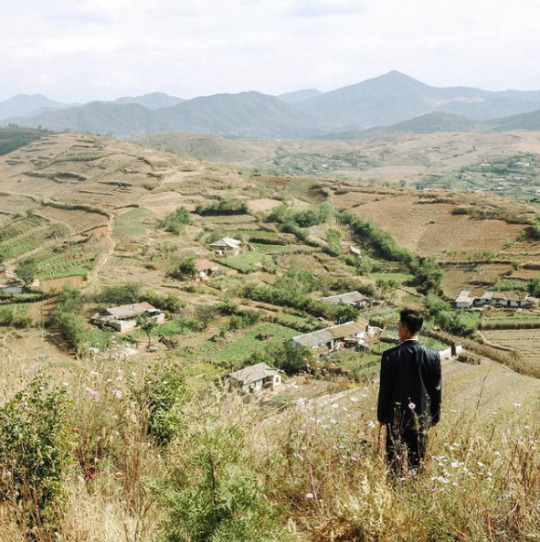
Hey, I'm back again with a very scary "tankie" post that asks you to think of North Koreans as people, and to consider their country not as a cartoonish dystopia, but as a nation that, like any other place on earth, has culture, traditions, and history.
Below is a collection of pictures from various cities and places in North Korea, along with a brief dive into some of the historical events that informs life in the so-called "hermit kingdom."
Warning: very long post
Kaesong, the historic city
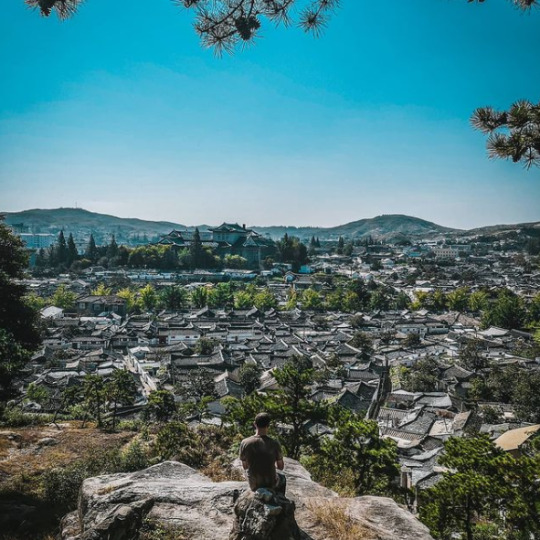
Beginning this post with Kaesong, one of the oldest cities in Korea. It's also one of the few major cities in the DPRK (i.e. "North Korea") that was not completely destroyed during the Korean war.
Every single city you'll see from this point on were victims of intense aerial bombardments from the U.S. and its allies, and had to be either partially or completely rebuilt after the war.
From 1951 to 1953, during what has now become known as the "forgotten war" in the West, the U.S. dropped 635,000 tons of bombs over Korea — most of it in the North, and on civilian population centers. An additional 32,000 tons of napalm was also deployed, engulfing whole cities in fire and inflicting people with horrific burns:
For such a simple thing to make, napalm had horrific human consequences. A bit of liquid fire, a sort of jellied gasoline, napalm clung to human skin on contact and melted off the flesh. Witnesses to napalm's impact described eyelids so burned they could not be shut and flesh that looked like "swollen, raw meat." - PBS
Ever wondered why North Koreans seem to hate the U.S so much? Well...
Keep in mind that only a few years prior to this, the U.S. had, as the first and only country in the world, used the atomic bomb as a weapon of war. Consider, too, the proximity between Japan and Korea — both geographically and as an "Other" in the Western imagination.
As the war dragged on, and it became clear the U.S. and its allies would not "win" in any conventional sense, the fear that the U.S. would resort to nuclear weapons again loomed large, adding another frightening dimension to the war that can probably go a long way in explaining the DPRK's later obsession with acquiring their own nuclear bomb.
But even without the use of nuclear weapons, the indiscriminate attack on civilians, particularly from U.S. saturation bombings, was still horrific:
"The number of Korean dead, injured or missing by war’s end approached three million, ten percent of the overall population. The majority of those killed were in the North, which had half of the population of the South; although the DPRK does not have official figures, possibly twelve to fifteen percent of the population was killed in the war, a figure close to or surpassing the proportion of Soviet citizens killed in World War II" - Charles K. Armstrong
On top of the loss of life, there's also the material damage. By the end of the war, the U.S. Air Force had, by its own estimations, destroyed somewhere around 85% of all buildings in the DPRK, leaving most cities in complete ruin. There are even stories of U.S. bombers dropping their loads into the ocean because they couldn't find any visible targets to bomb.
What you'll see below of Kaesong, then, provides both a rare glimpse of what life in North Korea looked like before the war, and a reminder of what was destroyed.
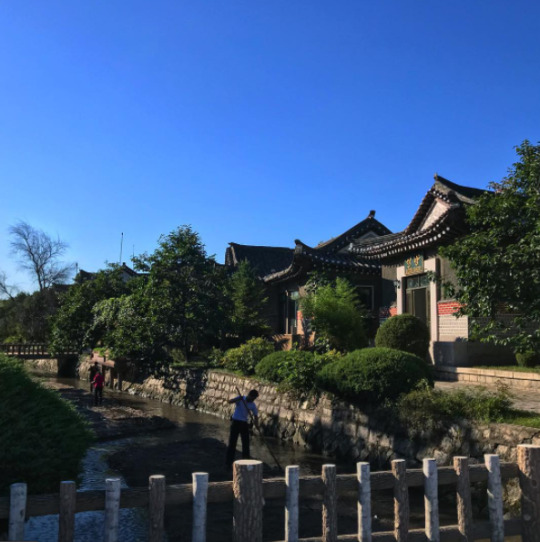
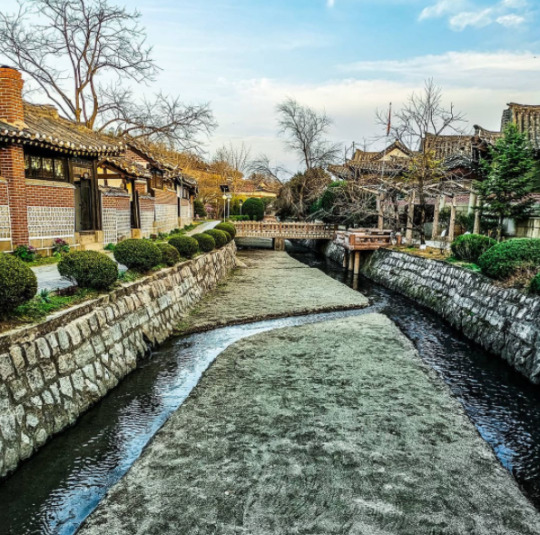
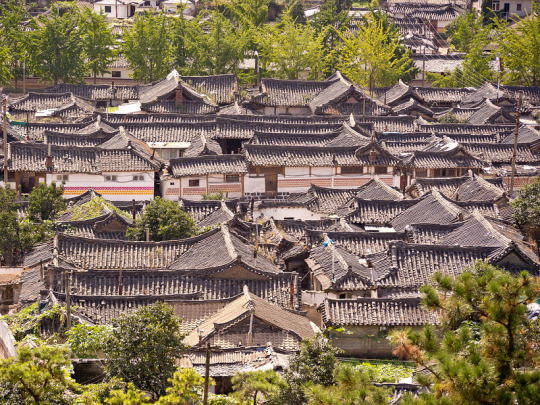
Kaesong's main street, pictured below.
Due the stifling sanctions imposed on the DPRK—which has, in various forms and intensities, been in effect since the 1950s—car ownership is still low throughout the country, with most people getting around either by walking or biking, or by bus or train for longer distances.
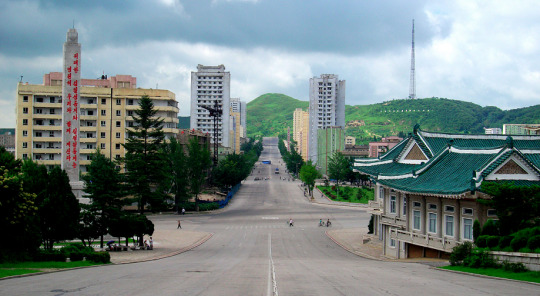
Kaesong, which is regarded as an educational center, is also notable for its many Koryŏ-era monuments. A group of twelve such sites were granted UNESCO world heritage status in 2013.
Included is the Hyonjongnung Royal Tomb, a 14th-century mausoleum located just outside the city of Kaesong.
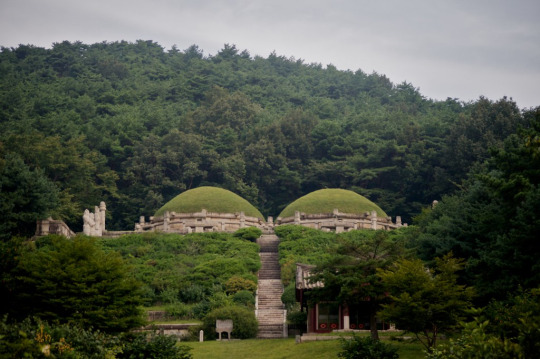
One of the statues guarding the tomb.
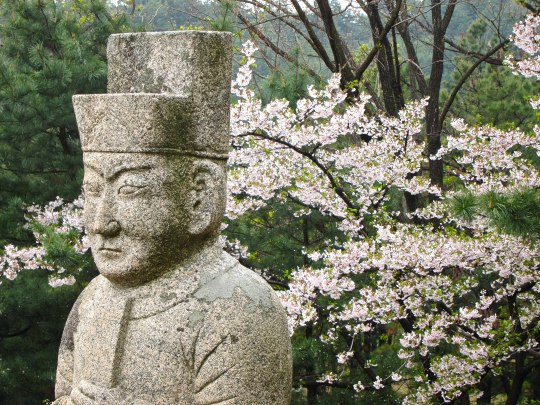
Before moving on the other cities, I also wanted to showcase one more of the DPRK's historical sites: Pohyonsa, a thousand-year-old Buddhist temple complex located in the Myohyang Mountains.
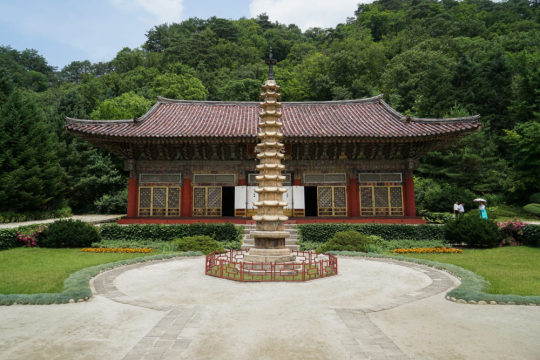
Like many of DPRK's historic sites, the temple complex suffered extensive damage during the Korean war, with the U.S. led bombings destroying over half of its 24 pre-war buildings.
The complex has since been restored and is in use today both as a residence for Buddhist monks, and as a historic site open to visitors.
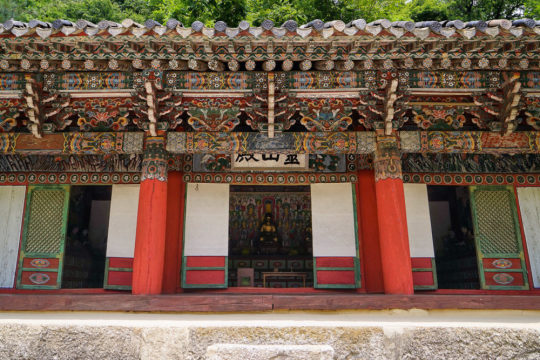
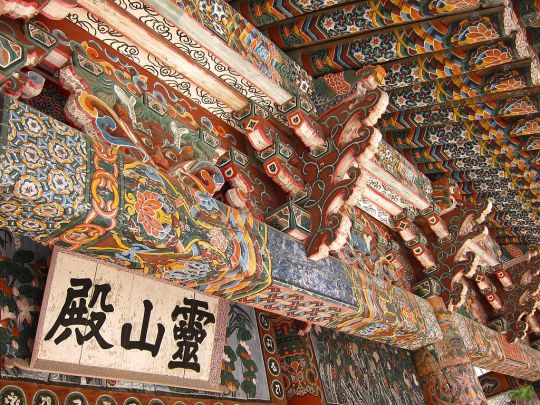
Hamhung, the second largest city in the DPRK.
A coastal city located in the South Hamgyŏng Province. It has long served as a major industrial hub in the DPRK, and has one of the largest and busiest ports in the country.
Hamhung, like most of the coastal cities in the DPRK, was hit particularly hard during the war. Through relentless aerial bombardments, the US and its allies destroyed somewhere around 80-90% percent of all buildings, roads, and other infrastructure in the city.
Now, more than seventy years later, unexploded bombs, mortars and pieces of live ammunition are still being unearthed by the thousands in the area. As recently as 2016, one of North Korea's bomb squads—there's one in every province, faced with the same cleanup task—retrieved 370 unexploded mortar rounds... from an elementary school playground.
Experts in the DPRK estimate it will probably take over a hundred years to clean up all the unexploded ordnance—and that's just in and around Hamhung.
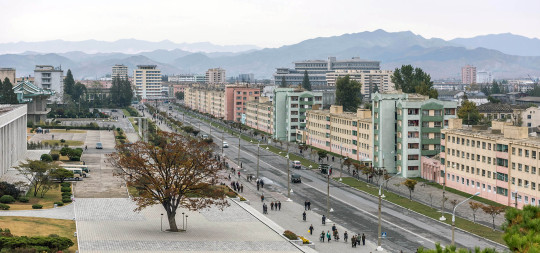
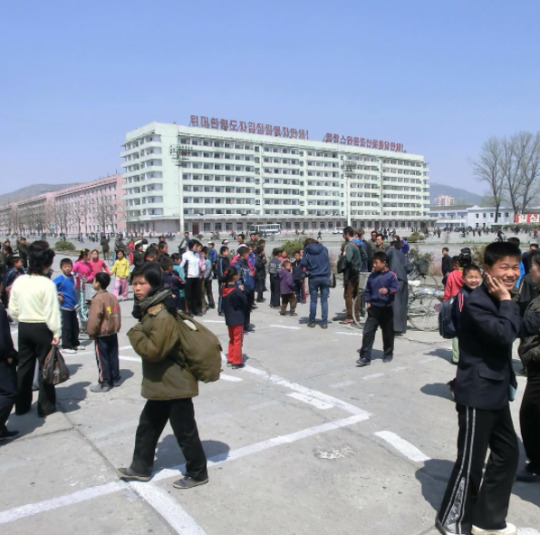
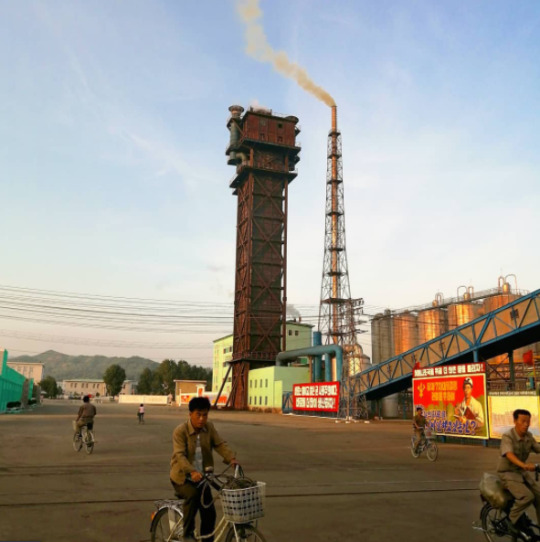
Hamhung's fertilizer plant, the biggest in North Korea.
When the war broke out, Hamhung was home to the largest nitrogen fertilizer plant in Asia. Since its product could be used in the creation of explosives, the existence of the plant is considered to have made Hamhung a target for U.S. aggression (though it's worth repeating that the U.S. carried out saturation bombings of most population centers in the country, irrespective of any so-called 'military value').
The plant was immediately rebuilt after the war, and—beyond its practical use—serves now as a monument of resistance to U.S. imperialism, and as a functional and symbolic site of self-reliance.

Chongjin, the third largest city in the DPRK.
Another coastal city and industrial hub. It underwent a massive development prior to the Korean war, housing around 300,000 people by the time the war broke out.
By 1953, the U.S. had destroyed most of Chongjin's industry, bombed its harbors, and killed one third of the population.
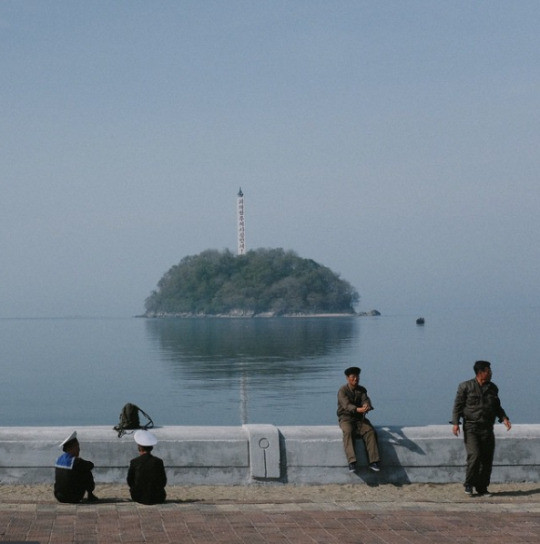
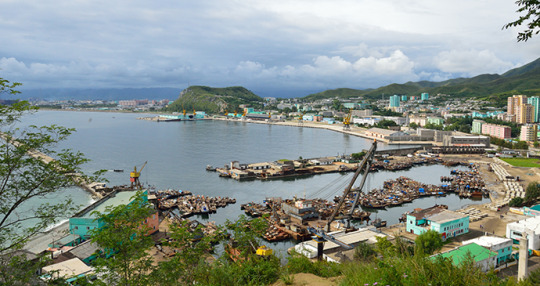
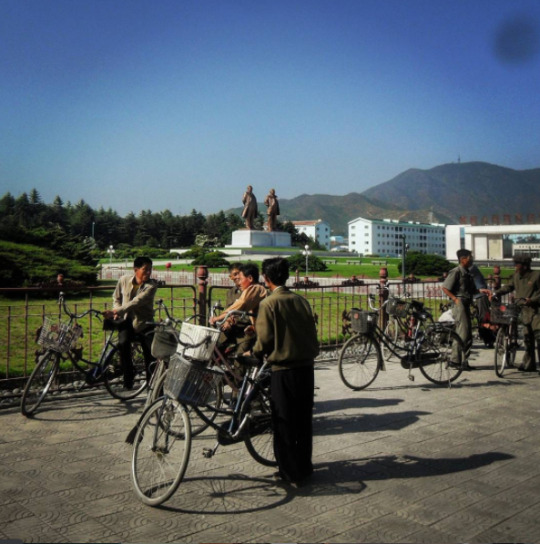
Wonsan, a rebuilt seaside city.
The city of Wonsan is a vital link between the DPRK's east and west coasts, and acts today as both a popular holiday destination for North Koreans, and as a central location for the country's growing tourism industry.
Considered a strategically important location during the war, Wonsan is notable for having endured one of the longest naval blockades in modern history, lasting a total of 861 days.
By the end of the war, the U.S. estimated that they had destroyed around 80% of the city.
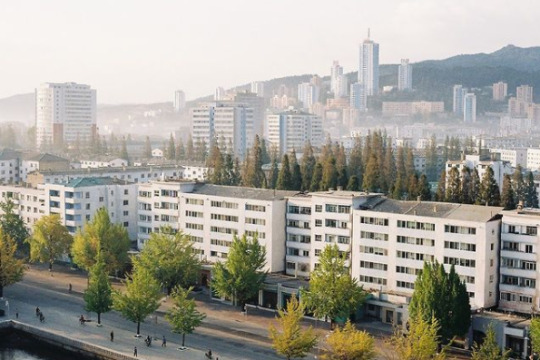

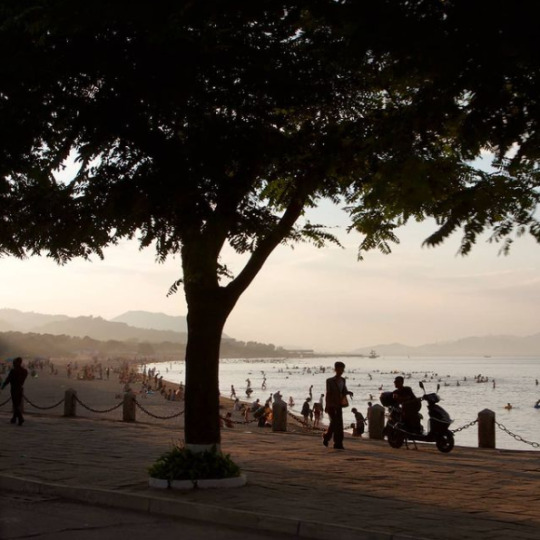
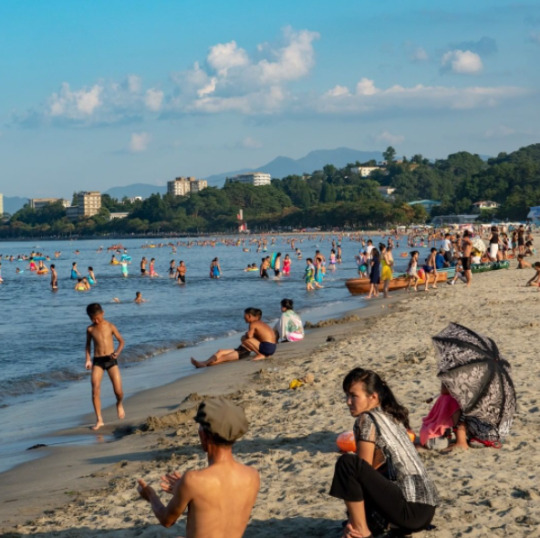
Masikryong Ski Resort, located close to Wonsan. It opened to the public in 2014 and is the first, I believe, that was built with foreign tourists in mind.
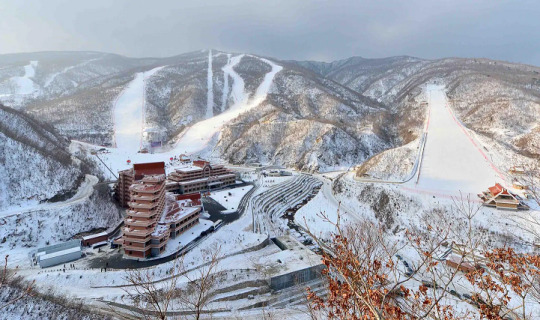
Sariwon, another rebuilt city
One of the worst hit cities during the Korean War, with an estimated destruction level of 95%.
I've written about its Wikipedia page here before, which used to mockingly describe its 'folk customs street'—a project built to preserve old Korean traditions and customs—as an "inaccurate romanticized recreation of an ancient Korean street."
No mention, of course, of the destruction caused by the US-led aerial bombings, or any historical context at all that could possibly even hint at why the preservation of old traditions might be particularly important for the city.
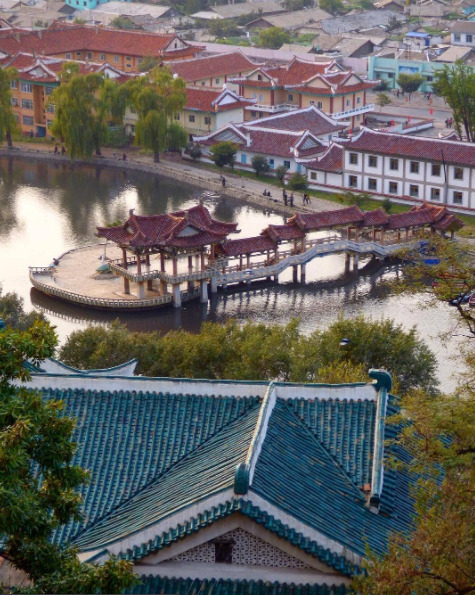
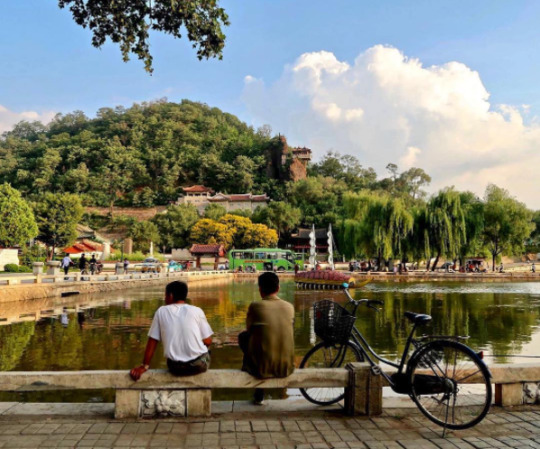
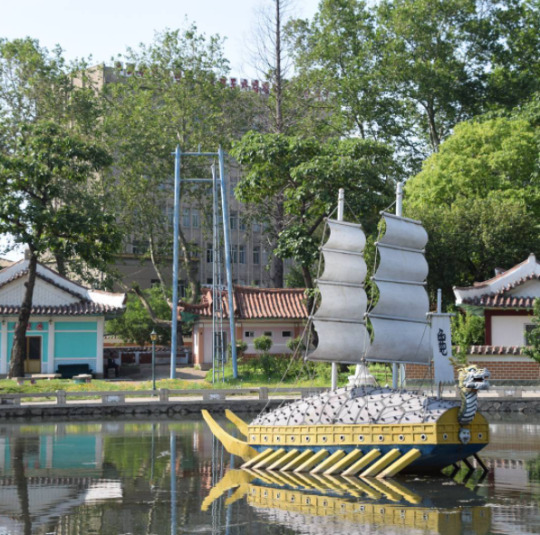
Life outside of the towns and cities
In the rural parts of the DPRK, life primarily revolves around agriculture. As the sanctions they're under make it difficult to acquire fuel, farming in the DPRK relies heavily on manual labour, which again, to avoid food shortages, requires that a large portion of the labour force resides in the countryside.
Unlike what many may think, the reliance on manual labour in farming is a relatively "new" development. Up until the crisis of the 1990s, the DPRK was a highly industrialized nation, with a modernized agricultural system and a high urbanization rate. But, as the access to cheap fuel from the USSR and China disappeared, and the sanctions placed upon them by Western nations heavily restricted their ability to import fuel from other sources, having a fuel-dependent agricultural industry became a recipe for disaster, and required an immediate and brutal restructuring.
For a more detailed breakdown of what lead to the crisis in the 90s, and how it reshaped the DPRKs approach to agriculture, check out this article by Zhun Xu.
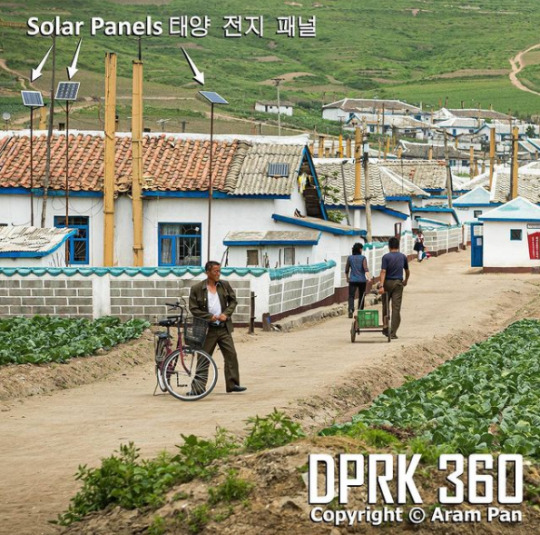
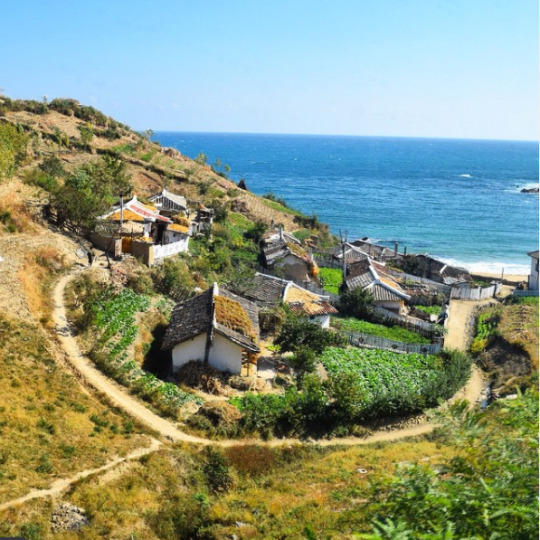
Some typical newly built rural housing, surrounded by farmland.
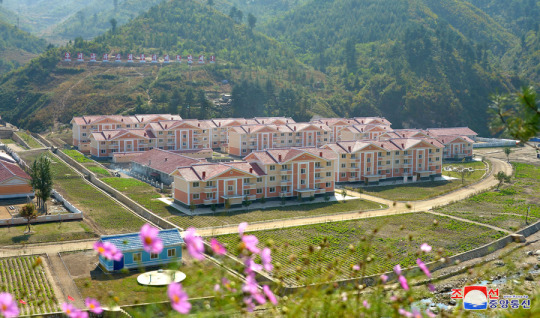
Tumblr only allows 20 pictures per post, but if you want to see more pictures of life outside Pyongyang, check out this imgur album.
#dprk#north korea#i've had this post unfinished in drafts for almost a year#also sorry about the spelling and potential formatting issues it's a nightmare to edit at this point#it was literally just meant to be a collection of picture and then the writing just sort of happened#enjoy the brief heritageposts history lesson i guess
7K notes
·
View notes
Text

1600’s anatomical engraving with alchemical symbolism /// by Gerhard Altzenbach
#etching#block print#skull#skeleton#macabre#old art#illustration#occult#witchy things#engraving#gothic#alchemy#esoteric#witchcraft#whimsigoth#old books#art history#hermetic#anatomy#goth art#goth#witch#spells#line art#b&w#mystical#occultism#old gods#heathen#art
3K notes
·
View notes
Text
Ok so I’ve fallen down a rabbit hole of researching period food & recipes, and,,,,
"one fifteenth century recipe contains the word "Chickens" four times-with four different spellings, of which the first is "Schyconys.""
excuse me medieval people but what the fuck
#I come onto this website and make jokes about medieval spelling#and then I see an actual period spelling and it’s so much worse than anything I could possibly dream up#medieval reenactment#medieval#medievalcore#history#i’ll be on my merry way now
11K notes
·
View notes
Text
When I was in school I went to a friend's house to work on a project on a Friday afternoon. At about 6 or 6:30 when the sun was about to set her mom called us over to the livingroom. She lit two candles with my friend and then they proceeded to put the lit candles inside of a little cupboard so no one could see them. Me, a young jewish teenager asked her, my catholic friend, why they did that and she shrugged, said it was a family tradition to bring peace and prosperity, that the women of the family did it every friday evening and then hid the candles. They were very catholic, so I bit my tongue and we went back to her room to study.
This is just one of many, many, crypto jewish traditions that still exist in my hometown of Medellín, Colombia and I want to share a little bit about them with you.
Medellín is the capital city of a region called Antioquia and it is currently the second biggest city in my country. Now the weird thing about my region and my city more specifically is that it is in the middle of fucking nowhere, like we are in a valley in the middle of the andean mountains and it would take over two weeks by river, horse and river, and dunkey and mule to even get here before the invention of cars or trains.
Now Medellín was founded over 400 years ago, and families had been coming to the region for way before then, so that means that for centuries getting to my city from the sea or from the other big cities in the country was incredibly hard. This was by design, because Medellín itself was founded by about 28 families and we know for a fact that alteast half of them were crypto jews hidding from the Spanish Inquisition, and both before and the foundation more and more jewish families arrived to the region.
This is a known fact, the DNA of the people from the region has a lot of sepharadic jewish mixed in there. Early Colombian literature dating up to the 1845 would call the people of my region the Neogranadine Jews or the Colombian Jews. But because they were crypto jews the religion and most of the traditions were lost during the 400 years that have passed, now over 90% of the population is catholic and don't really know about their origins.
But some things stuck. And I want to tell you about them.
On the 7th night of December there is this pre-christmas festival called "El día de las velitas" or the little candle night that started and was unique to Antioquia. It's supposed to commemorate the candles that people had in the streets and the windows on the night Jesus was born and that helped Mary and Joseph to find their way. Do you know how this unique festival is celebrated in my city? People take to the streets to light candles, small colorful candles that they put in wooden planks or directly on the streets, it's the night that people decorate and turn on the christmas lights and it is so important and popular that we have an actual day off on the 8th of december.
Let me show you a few pictures


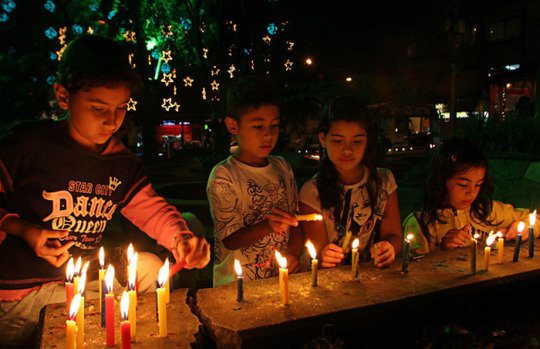
I don't think I need to explain this one. Even most goyim will know about Hannukah. But it is the weirdest thing when the dates coincide and we are all lighting candles together.
My dad was in the Jewish community board and we needed to rent a place to put our jewish daycare. They found this beautiful old house that had belonged to a family in colonial times but needed a little TLC. We had them remove some wooden floors because they were too old and rotting and found a huge Magen David made out stones in the center of the floor. The house also happened to have two separate kitchens and a mikveh or immersion bath in one of the rooms. These a very traditional things that colonial houses have in my region.
My grandmother converted to Judaism so I have a side from my family that is 100% from here and didn't arrive during the 20th century. I had the pleasure to meet both of my great grandparents from that side though they died when I was young. My grandma tells me that my greatgrandmother used to have one of these immersion baths in her house when she was growing up. Women were supposed to bathe in them after their periods had ended, my catholic great grandmother respected the mikveh traddition more than I ever have.
(I wish I had photos from that specific house but this happened over ten years ago, I'll show you some immersion baths from a different colonial houses that are also in my city)
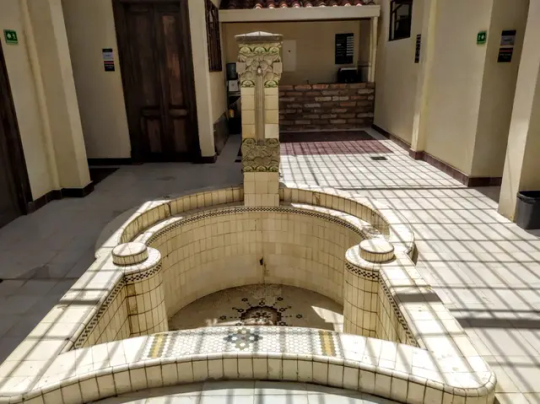
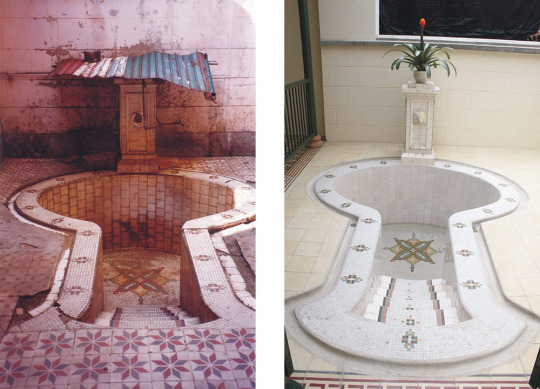
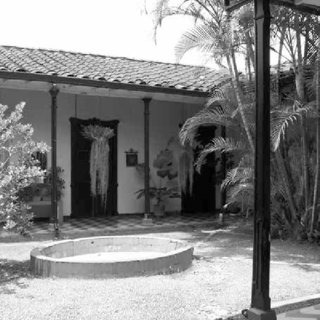
Now how about we talk about traditional clothes. I'm sure most of you have heard of Ponchos, which are traditional in the Andean region, well the one from Antioquia is a little different and it's always supposed to be worn with a hat. Let's see if you can spot what I mean.
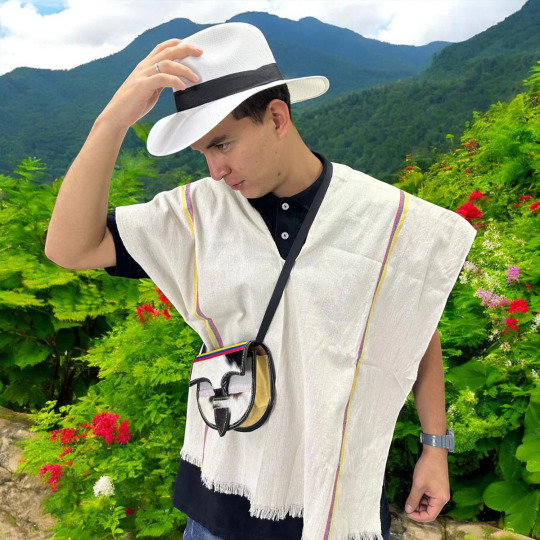



A few years ago Spain decided to grant citizenship to the descendants of the Jewish people that they had exiled in 1492. To get it you had to prove through family trees that your family had been Jewish. My city got the most ammount of passports out of everyone in the world, more than Israel. I could have applied from both my family that came from Egypt in the 20th century (we still have the keys to our house in Spain) or through my catholic side, as both of my grandmother's last names applied. I didn't but I could have.
I don't really know why I decided to finally write this post. I have so many more stories. I just think it's both incredibly sad that so much Jewish culture and people were lost but also it's a little heartwarming to see what survived even centuries down the line.
#it took me years to decide to finally write this because i didn't want to put where i live out on the internet#but fuck it#i still don't know how i feel about this#it's a bit of mourning what could've been and a bit of look a this isn't it neat#there is so much more to say about this topic but the post is too long#like how a lot of jews changed their last name to “Rojas” which spelled backwards means “lizcor” or to remember and they still forgot#or how there is a movement of reclaiming the jewish roots we have three re-emerging jewish communities in our city#one of which already converted fully and they are WAY more obvservant than my regular traditional community#crypto jews#conversos#jumblr#jewish#jews#judaism#jewish history#colombia#medellin#lationamerica#latin america#south america
750 notes
·
View notes
Text
i feel like dream in human aus is usually characterized as being more stoic and stern while hob is more easygoing, but i think it would be funny to have a university au where hob is the professor who's like "no work is deserving of 100%. find 27 more sources and do it again" while dream is just like "they put their dreams into it, hob 🥺 A+! A+! A+! A+!"
#hob: you got this date wrong in the paper. c-#dream: i like all the misspelled words. really adds personality to the story. A+#hob is the ideal teacher for students whove always gotten good grades easily and need someone to challenge them more#dream is the ideal professor for students who struggle with self confidence and need to feel more capable#hob should only teach 400 level senior classes. dream teaches Intro to Poetry 😂#one time they swap papers to grade and then hob's like 'dream why did you give all my students As' dream's like 'they tried their best 🥺'#hob's like THEYRE HISTORY MAJORS DOING THEIR DISSERTATION AND YOU LET ONE OF THEM SPELL HATE AS 'H8'#dream: why'd you give my students Bs :(. hob: one of them turned in a coffee stain as a poem? wth#dream: everything is poetry hob. it's abstract. oh my god you dont get it at all 🙄#dream's unconventional method does work tho. he has an uncanny ability to get even the most disengaged students to care SOMUCH about poetry
512 notes
·
View notes
Text
The oldest Ninjago Fanfic that I can find is dated December 4th, 2011. This was almost a year after the pilots initially aired and two days after Rise of the Snakes/Home aired.
As you cannot backdate works on fanfiction.net, the date published is the final date. And if no other fic had been there pre-mass deletion of fics in 2012/deleted any time before this moment, this is the first recorded fanfic in the fandom! (At least on ffn.)
The Fanfic in question is Tale of Cole: First of a LEGO Ninjago Trilogy by user TLFScarheart12.
Cole tells Kai about his early training and what he learned after facing a Kaiden.
This is the first of three fanfics in a series, as the title suggests. The other two are about Zane and Jay. (The Jay one even has a mention of an oni in the description!) I took the time to sit down and read this first one, and it is a nice little read!
Cole tells Kai a story about how he was convinced to actually try to be a team with Zane and Jay.
It sort of places Cole in a similar place to where Kai was in the pilots. He's trying to be the best, and in turn, he doesn't accept Zane and Jay's teamwork. SPOILERS: They end up saving him from the kaiden and he eventually learns the importance of teamwork.
For a fic that came out two days after the actual show aired, it works super well, I'd say!! It's a fun little read and a neat tidbit of our fandom's history!! It's also this author's first fanfic on their account, which consists of mostly Ninjago based works!!
#fanfiction#ninjago#ninjago fandom history#cole ninjago#the reason i bring up backdating is that you can do that on ao3 and you cant really be SURE if the dates true or not iykwim????#ffn#TLFScarheart12#guys i messed up i spelled two things wrong and now this gonna be circulating with spelling mistakes NOOO#grammar mistakes. not spelling mistakes. i need to go to bed
285 notes
·
View notes
Text
The Stele of Aphrodite : an Ancient Greek Love Charm ☆💗☆
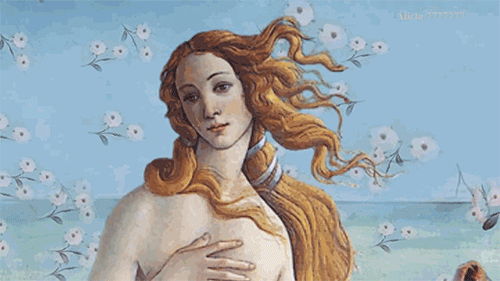


Many love spells in the ancient world, particularly in the PGM are that of what are known as fetching charms, or binding spells: love spells targeting specific people. However, there are a number of more generalized love spells, ones with no particular target, such as the Stele of Aphrodite.
The Stele of Aphrodite is Greek Magical Papyri (PGM) spell number IV. 1265-74, and dates back to the late Hellenic period of ancient Greece. It was used primarily for love magic, specifically to invoke the favor and obsession of a desired individual, as well as for favor and success within friendship, popularity and beauty. The stele was believed to harness the power of Aphrodite, the goddess of love and beauty, to sway the emotions and actions of whoever sees you in favor of the practitioner.


Step by step instructions on how to create your own below ☆
Read the full article for free here
#ancient greece#helpol#hellenic polytheism#aphrodite#aphrodite devotee#love spells#love magic#charms#spell tips#spellwork#pgm#greek sorcery#greek gods#greek magical papyri#greek mythology#goêteia#hellenic pagan#ancient history#witchblr
303 notes
·
View notes
Text

ᴊᴏʜɴ ᴡɪʟʟɪᴀᴍ ᴡᴀᴛᴇʀʜᴏᴜsᴇ 𝙏𝙝𝙚 𝙈𝙖𝙜𝙞𝙘 𝘾𝙞𝙧𝙘𝙡𝙚. 1886. Oil on canvas: 183 × 127 cm.
#19th century#1880s#mythology#gothic#witchcraft#magic#art#paganism#art history#divination#wicca#nature#spells#magick#supernatural#witchblr#victorian#divine feminine#pre raphaelite#john william waterhouse
83 notes
·
View notes
Text

"I hope you are not getting tired working, but I want presents, and I want as many as you can spare. I want a silver cornet, a bick (bike), and a velocipede for brother, Christmas I think you are getting old, so I sent you a letter. Yours truly Verne U. Lee."
(source: The Ontario (California) Record, December 22, 1896.)
#'but I want presents'#I also love the 'I think you are getting old'#yeah I guess you could drop dead at any time santa so I figured I shouldn't wait any longer to write#I also truly admire the fact that he managed to misspell bike yet correctly spell velocipede#dear santa#california#kids#1890s#victorian#history
104 notes
·
View notes
Text

New Medieval Books: The Galdrabók: Forbidden Icelandic Folk Magic
64 notes
·
View notes
Text

I am absolutely in love with Babel. Griffin and his slay squad needed more screen time.
#babel#griffin lovell#griffin harley#Evelyn brooks#ramiz rafi mirza#robin swift#babel an arcane history#babel or the necessity of violence#babel rf kuang#rf kuang#anthony ribben#?#sterling jones#I don’t know how to spell their names#i listened to an audio book#they all kiss#letitia price#viktoire degraves#booktok#babel fanart#babel an arcane history fanart
173 notes
·
View notes
Text
hey remember the epidemic of EXPLODING TEETH CURSES going around in the 1800's? i still think the banning of that spell was one of the most massive overreaches of Council authority in living memory. like it wasn't even killing people
91 notes
·
View notes
Text
The Sinners ending is really sad, but bittersweet. I love how Sammie being the sole survivor implies that despite religion trying to demonize it and white supremacy trying to steal it/make it conform, a culture's spirit will always find a way to survive.
Everyone succumbed to either vampirism or the fight against white supremacy, except for Sammie. Even in the face of multiple family members telling him to give up music, Sammie persists.
Slim LITERALLY TELLS HIM the Devil will have to go through him first. Pearline ends up sacrificing herself trying to defend him. STACK AND MARY LEAVE HIM BE TILL HE'S AN OLD LEGEND!!!
Even though 4 survive the night, he's the only one that gets to grow old. Technically, he's the only one that really lives. (Don't ask me what Mary and Stack's survival means in this metaphor, idk yet.) The Griot, the one who keeps culture alive and kin connected across time, is the one that comes out of that hellish night not untouched, but still able to thrive.
I will cry over every single death, but that detail is really fucking neat.
#you will have to pry this movie from my cold dead hands i fear#there is so much to unpack#lemme go learn about griots and firekeepers and filídh#i didn't realize there was a history of property owning Chinese Americans in the DELTA#till i read the wiki page#i will simply never get over this film#also fuck I've been spelling sammie wrong the whole fucking time#hyena watches#sinners#sinners spoilers#ryan coogler
49 notes
·
View notes
Text
Gender fluid? No.
Gender oobleck.
My gender nothing concrete until grabbed/perceived into shape another makes of me. Then i slip away.
Also. You shouldn't pour me down the drain.
#mine#gender#gender oobleck#nonbinary#gender apathetic#apagender#gender queer#oobleck#did this make any sense?#been on my brain but idk if anyone else understands it#no but seriously#as long as i know you're referring to me I'm not really all that torn up about gender and how I'm perceived#I've been called Michael before#that's not my name but it was part of the name i have for my server profile on that discord server#so i knew what they meant#also#my 8th grade history teacher used the typically masc spelling for my name for the textbook i was given#and i just found it funny cause he had the roster beside him#i didn't care though#just was confused at first#fggdf
72 notes
·
View notes
Text
Direct Vision Spell for an Oracle 𓂀
A 2000 year old Greco-Egyptian magic spell

─── ⋆⋅☆⋅⋆ ──
[PGM V 54 – 69]
So sick of all these fake bs Tumblr and Pinterest spells-
"what color candle means what lol" with zero cultural or historical significance, it's like they just pulled things out of their ass.
So, here is a real 2000 year old Greek and Egyptian syncretic spell from Thebes to receive a direct vision from the beyond....WITH cultural and historical context.
Because, yes, history is important, and anyone giving you "spell tips" without telling you where the fuck they're from or what they mean is bullshitting you.
Ancient Greek oracular spells were rituals and invocations performed to gain insights or predictions from the gods, the Theoi, as well as Daemons and the Dead, particularly through seers known as oracles.
The Spell: PGM V 54 – 69 from the Greek Magical Papyri
Context of the Spell:
This spell is an interesting blend of Egyptian and Greek oracular practice: the use of Coptic or Egyptian eyepaint, kohl, here is interesting– as well as it's mixture with water from a sunken ship. Water from such locations are normally reserved for love spells, as we see previously in the PGM. The relationship or correspondence between a literal sunken vessel and sinking into the throes of passion. However, here, with its use in an oracular spell, it seems to correspond more to the chthonic or otherworldly realm, giving te wearer the ability to see past the normal, mundane world; past the ‘veil’ so to speak and into the beyond.
The use of the magical mystery word or voces magicae “Akrammachamarei” here is also notable; it is quite often seen throughout the PGM, and is associated with the God/Daemon/Archon of both Gnostic (Jewish-Egyptian) as well as Greek origin, Abrasax.
In spell PGM V. 96-172, Abrasax is identified as part of the "true name which has been transmitted to the prophets of Israel" of the "Headless One, (also known as the Egyptian god Bês) who created heaven and earth, who created night and day ... Osoronnophris whom none has ever seen ... awesome and invisible god with an empty spirit"; the name also includes Iaō and Adōnai, the ineffablenames of the Jewish god. "Osoronnophris" represents Egyptian Wsir Wn-nfr, or "Osiris the Perfect Being.” Another identification with Osiris is made in PGM VII. 643-51: "you are not wine, but the guts of Osiris, the guts of ... Ablanathanalba Akrammachamarei Eee, who has been stationed over necessity, Iakoub Ia Iaō Sabaōth Adōnai Abrasax."
Instructions:
─── ⋆⋅☆⋅⋆ ──
After you have purified yourself (through ritual bathing and declarations) you must put on your clean linen robes and sandals of Papyrus.
Then, taking a purified bronze censer, place the laurel leaves inside and light them until the smoke fills the room. Walk clockwise around the room, and your workspace, Chanting the Ephesia Grammata:
ΑΣΚΙ(ΟΝ) ΚΑΤΑΣΚΙ(ΟΝ) ΛΙΞ ΤΕΤΡΑΞ ΔΑΜΝΑΜΕΝΕΥΣ ΑΙΣΙΟΝ (or ΑΙΣΙΑ)
“askion kataskion lix tetrax damnameneus aision”
Then, taking the olive oil, pour it into the waiting bronze dish.
With your right hand, anoint your right eye with the prepared water from a shipwreck.
With your left hand, mix 1 part kohl with 1 part water until it is a viscous paint, from the same dish, and anoint your left eye so that it is completely surrounded by the paint.
Then, pronounce the incantations:
"EEIM TO EIM ALALĒP BARBARIATH / MENEBREIO ARBATHIAÔTH IOUĒL IAĒL OUĒNĒIIE MESOMMIAS,
let the god who prophesics to me come and let him not go away until I dismiss him,
OURNAOUR SOUL ZASOUL / OUGOT NOOUMBIAOU THABRAT BERIAOU ACHTHIRI MARAI ELPHEŌN TABAŌTH KIRASINA LAMPSOURĒ IABOE ABLAMATHANALBA AKRAMMACHAMAREI.”
Once the incantations are finished, present any offerings and ask over the prepared olive oil dish what your question(s) are. Stare into the oil, lit only by candle or oil lamp light, and you will receive a direct vision.
─── ⋆⋅𓂀⋅⋆ ──
For more information & how to pronounce the incantations, check here.
#chthonic sorcery#greek sorcery#sympathetic magic#ancient egypt#ancient history#ancient greece#greek magical papyri#pgm#coptic#Goêteia#oracle#visions#spellwork#spells#spell tips#witch tips#witchblr#witch community#Abrasax#gnosticism#anthropology#divination#divination spell#traditional witchcraft#Greco-Egyptian polytheism#oracles#greek oracle#prophesy#oracle of delphi#incantations
104 notes
·
View notes